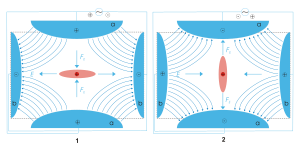
In experimental physics, a quadrupole ion trap or paul trap is a type of ion trap that uses dynamic electric fields to trap charged particles. They are also called radio frequency (RF) traps or Paul traps in honor of Wolfgang Paul, who invented the device[1][2] and shared the Nobel Prize in Physics in 1989 for this work.[3] It is used as a component of a mass spectrometer or a trapped ion quantum computer.
- ^ Paul W., Steinwedel H. (1953). "Ein neues Massenspektrometer ohne Magnetfeld". RZeitschrift für Naturforschung A 8 (7): 448-450
- ^ DE 944900 "Verfahren zur Trennung bzw. zum getrennten Nachweis von Ionen verschiedener spezifischer Ladung", W. Paul and H. Steinwedel, filed on December 24, 1953, priority December 23, 1953
- ^ Wolfgang Paul (1990). "Electromagnetic traps for charged and neutral particles". Reviews of Modern Physics. 62 (3): 531–540. Bibcode:1990RvMP...62..531P. doi:10.1103/RevModPhys.62.531.